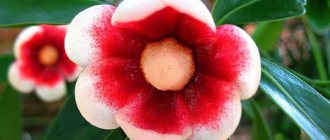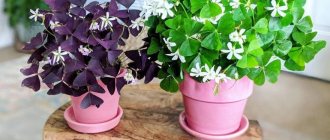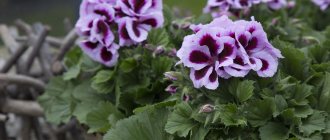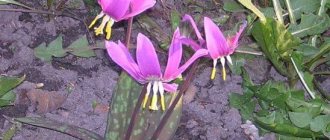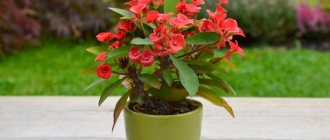“Our Christmas star” - this is how people speak fondly of this plant, because in many countries not a single Christmas celebration is complete without it.
Breeders have been able to develop several beautiful poinsettia varieties that can be cared for at home - spotted, creamy white, lemon, apricot and red. The flower was first discovered in 1825 in Mexico and exported by the American ambassador as a gift to South Carolina botanists.
Description and photo
Poinsettia (Christmas flower) belongs to the shrubby perennials, the genus includes several species: poinsettia most beautiful, large-horned, spherical, shiny, Mile . It can be either biennial or annual. The shoots are usually erect, branched, the leaves are usually bright green, but are also found with a cream edging along the edges. The cuttings are orange-red, the flowers are small, yellow-green.
Below are photos of the main varieties of poinsettia suitable for propagation and care at home.
Photo of how the most beautiful poinsettia blooms
Photo of blue poinsettia
Photos of poinsettias of other colors
Poinsettia: signs and superstitions
The second popular name of the flower is “Christmas star,” since poinsettia is considered a symbol of this bright holiday and is endowed with some mystical power. So, for example, if there is an ill-wisher in the house or strong negativity appears, the plant turns sharply yellow and may even die, taking on negative energy.
In addition, there is a belief that a poinsettia decorating the newlyweds’ bedroom will bring the family quick offspring, give the woman even more charm, and will stop the man from looking at anyone else besides his wife.
Care
After the purchase
Poinsettia care begins immediately after purchase. Therefore, the first thing you need to do is place the flower on a lighted windowsill, protected from drafts - there it will get used to its new place of residence in the next 3 weeks. In addition, such a quarantine is needed for protection: if pests are found on the poinsettia, they will not spread to other house plants.
Another nuance is store-bought soil. Experienced flower growers know that it is a kind of transit point for flowers and they cannot grow for a long time in an acidic environment. Therefore, the second step is replanting into a new pot with fresh soil.
Don't risk it - don't buy poinsettias at markets in winter. Most likely, they will sell you a plant with frozen roots that will not live long.
Priming
Choose a slightly acidic, loose substrate for your home “star” . Ideal option: a combination of peat, sand, turf and leaf soil in a ratio of 1:1:3:3. Add a handful of humus as well. Drainage - river pebbles, expanded clay, broken brick.
Don’t forget to lightly loosen the soil a couple of times a week.
Top dressing
It is necessary to feed poinsettia every 2 weeks from spring to autumn with a mineral fertilizer complex.
In the summer, add a weak solution of mullein to the “menu”, and during the flowering period - fertilizer with potassium (for flowering ornamental plants).
Location and lighting
Poinsettia loves light, so it is not afraid to stand even in sunny places. In warm, windless weather, take the plant out into the fresh air (garden or open balcony), but if this is not possible, ventilate the room more often, avoiding drafts.
In winter, when daylight hours are short, provide additional lighting. Buy a phytolamp for this and install it at a distance of 25-30 cm from the plant. But in the fall, before flowering, there is no need to add additional lighting.
Watering and humidity
The basic rule is to water after the top layer of the substrate dries. The soil should not be allowed to become waterlogged - this will lead to rot on the roots. In summer, watering is frequent, in winter and after flowering - less often.
Use purified water at room temperature . Tap water is not suitable - it contains too much chlorine and salts. Collecting rainwater is difficult and time-consuming; river water contains a lot of heavy metals. You can buy distilled water or leave tap water for at least a day in a container without a lid.
If, after overwatering, the poinsettia begins to wither, urgently transplant it into a new substrate.
Dry air has a detrimental effect on poinsettias, so do not forget to humidify the air.
You can do this using a special device, or by placing a saucer near the plant and regularly adding water to it. A couple of times a week (more often in summer) spray the poinsettia and clean its leaves with a soft cloth to remove dust.
Temperature
Poinsettia requires a constant temperature: not lower than +18 and not higher than +25 degrees in both summer and winter. During the rest period – within +12-14 degrees. The plant does not tolerate sudden temperature fluctuations .
Rest period
The star's rest period lasts from March to April. At this time, it is better to move it to a darker place, lower the temperature around it, and water sparingly and rarely.
Transfer
The plant should be replanted every year, in April-May. Moreover, preparation for the procedure begins in March: the stems are cut by a third, placed in a warm room where there will be enough lighting, and watered with warm water. When new leaves appear on the poinsettia, it is transplanted into a larger pot, placed in a warm place and generously sprayed and watered.
Trimming
Pruning solves two problems . Firstly, it allows you to give the poinsettia a more neat appearance. To do this, pruning is carried out after flowering, leaving stems 10-12 cm long. At least 5-6 healthy shoots should be left on the flower.
Secondly, it gives an impetus to flowering in young plants, and is carried out as described above. Afterwards, it will be possible to pinch out the green parts of the plant when the rudiments of future inflorescences begin to form on the shoots.
But remember: if you decide to prune your poinsettia in winter and not in spring, be sure to supplement it with a phytolamp.
Do not use scissors for pruning - they greatly damage the stems. Buy a special blade for this and be sure to disinfect it with a solution of potassium permanganate or salicylic alcohol.
Step-by-step instructions for transplanting at home
Poinsettia has a relatively small but fragile root system.
The slightest damage to the root can cause irreparable harm. Taking into account this feature, transplantation is carried out using the transshipment method, preserving the root ball of soil . To remove the plant from the pot, it is recommended to spill the soil mixture with warm water 15 minutes before transferring.
For transplantation you need to prepare:
- new pot (1-2 cm wider and 3-4 cm deeper than the old one);
- gloves for work;
- drainage (expanded clay, small pebbles, gravel);
- new substrate.
- 3 cm of drainage is placed at the bottom of the pot.
- Next, the substrate is poured and the flower removed from the old pot is transferred.
- All voids are filled with prepared soil mixture.
- The flower is watered moderately with water and covered with a transparent cap for a month. The cap must be opened daily to prevent rotting.
Reference! For poinsettia, slightly acidic soil pH = 5.4-6.3 is suitable, which contains: leaf, clay-turf, peat soil and sand, maintaining a ratio of 2:3:1:1.
Bloom
What can I do to get my poinsettia to bloom at Christmas?
If you want to amaze your loved ones with the marvelous blooming of poinsettia, start acting in the fall. Since flower buds are formed when the plant is in the dark, you need to artificially shorten the daylight hours. For two months in a row, cover the poissentia with a dark bag at dusk , or put it in a dark place for 12-14 hours.
The first buds will begin to form within 3 weeks, and after 6-8 weeks the first flowers will bloom. Make sure that during the flowering period the temperature does not drop below +14 degrees - only in this case the bracts will have a bright color.
Care after flowering
After flowering, the poinsettia is pruned and put into rest mode: the stems are shortened and the pot is placed in a dark, cool place until May.
How and where else is the “Christmas Star” used?
The plant is quite popular among many gardeners. During its flowering, the upper leaves become not only red. Additionally, in the area of the inflorescence, a cap of pink, crimson, beige, and white leaves is found. In addition to the Christmas star and poinsettia, the flower also has the names Star of Bethlehem and Christmas flower. The plant is a perennial plant and blooms at a certain period. So that it can please loved ones for the New Year holidays, it needs special care. A feature of poinsettia flowering is considered to be its blooming in late autumn, closer to winter, when the days become more or less short.
If the lights are turned on in the rooms in the evening and in the morning, then the photoperiod for the flower increases and its regime is disrupted. The correct supply of light to the plant must be carefully monitored, otherwise additional results are unlikely to be achieved. The star's buds and flower buds form when a short day begins to set in, with a period lasting no more than ten hours a day.
Popular articles Silver birch
Reproduction
Cuttings
The ideal time for breeding is April.
- Cut off the apical shoot 10-12 cm long. In this case, there should be 5-6 internodes on the cutting.
- Rinse the cut under running water and blot away any remaining moisture with a dry cloth. The escaping juice prevents the healing of the cut, clogging the plant’s vessels, so sprinkle the wound with crushed charcoal or activated carbon and treat the lower part of the cutting with a root formation stimulator (for example, heteroauxin).
- For rooting, you can plant the cuttings in moist soil (a mixture of sand and peat) or a glass of water. The depth of planting in the ground is no more than 1.5-2 cm. If you bury the cutting too deeply, it may begin to rot. Build a greenhouse around the cuttings, covering the container with plastic film or glass. The temperature inside should be between +20-24 degrees. Do not forget to moisten the soil and spray the cuttings.
- After about a month, the cuttings with a formed root system can be transplanted into pots (18-20 cm in diameter), pinch their tops (this allows you to immediately get a branching bush with bright inflorescences) and care for them like adult plants. But don’t expect flowering right away - it will happen, at best, in the second year of the poinsettia’s life.
Why is propagation by seeds not used?
Pollination by seeds is easy under natural conditions, but at home the procedure is not so simple and depends entirely on the dexterity of the poinsettia owner. Flowers need to be pollinated independently, which not everyone can do correctly , wait for the seed pods to ripen, collect and properly store the seeds. In addition, keep in mind that plants grown indoors do not carry the properties of the parent flower.
Seeds are stored in a bag without paper, in a dry and dark place. If even a drop of moisture gets inside, the seeds will become moldy. Seeds should be planted in the spring, after keeping them in the refrigerator for stratification.
How does poinsettia propagate from cuttings?
Cuttings are the easiest method of propagation. To do this, use cuttings up to 15 cm long, taken after pruning the plant. Rooting is done in mid-spring or early summer. Before you begin propagation, the cut cuttings must go through 3 stages of preparation:
- the lower leaves of the planting material are removed, and the leaf plate of the upper ones is cut off by ⅓;
- the cut site is kept in water, and then dried in the sun for several minutes;
- For rapid rooting, cuttings are treated with a root formation stimulator.
After the preparatory stage, the cuttings are ready for planting. To do this, select nutritious, moisture-permeable soil and small pots with drainage holes. The cuttings are buried 3 cm into the soil and placed under a microgreenhouse. A young plant requires careful care:
- watering as the soil dries out;
- bright diffused light;
- the air temperature should be kept within +25°C;
- periodic ventilation and spraying of cuttings.
This simple care is enough for the cuttings to begin to take root within two months. As soon as the seedling has young leaves, it can be safely transplanted into a larger pot and removed to a permanent place.
At the beginning of active growth, the top of the plant is pinched so that the plant begins to develop as a small shrub.
Cuttings are a simple and convenient method of propagation
Plant toxicity
Many are concerned about the presence of poisonous milky juice in poinsettia tissues, as in other members of the family. It contains cyanogenic compounds, euphorbine and ascorbic acid, which can cause skin inflammation, burns, gastrointestinal upset, and even temporary blindness if they get into the eyes.
However, do not panic ahead of time! According to research, in order to get a significant dose of poison in the stomach, a child must eat at least 500 leaves of the plant, and dermatitis resulting from contact with the juice of the skin occurs when a person is particularly sensitive to plants of the euphorbia family.
But, since small children have very delicate skin, it is better to move the pot higher. By the way, every second person with a latex allergy also has a negative reaction when they come into contact with pointe.
Poinsettia - what kind of plant?
This plant is very unusual. It stands out not only for its bright foliage, but also for its “way of life.” In winter, the culture reaches its peak of decorativeness, and in the summer it goes into retirement.
Since the poinsettia “dresses up” just in time for Christmas, it is also called the “Christmas star” or “Star of Bethlehem”. The culture is better known to science as the most beautiful euphorbia.
Interestingly, poinsettia flowers are small and inconspicuous, and the bright leaves on the plant are bracts.
Moreover, the classic “Christmas star” is distinguished by red bracts. But in fact, there are a great variety of colors: pale pink and crimson, rich yellow and lemon, as well as spotted. It all depends on the variety of poinsettia.
Cinnamon Star
Dolce Rosa
Eckespoint Primero Gingle Bells
Enduring White
Monet Twilight
Winter Rose Red
Pests and diseases
- If there is insufficient light during flowering, the plant will shed its leaves.
- Why do poinsettia leaves turn yellow and fall off? Most likely, your indoor flower was in a draft.
- Do the inflorescences also fall off along with the leaves? You have flooded the soil too much with water and the root system has begun to rot.
- The leaves around the edges began to turn yellow, become covered with brown spots and curl - the air in the room is too dry.
- High air humidity provokes the appearance of gray rot. Gray spots of mold appear on the stem and shoots, and a scattering of brown spots appears on the leaves. The drugs “Fundazol” or “Topaz” will help to cope with the disease.
- Ugly growths on the leaves indicate a violation of the feeding and watering regime.
- Chaotically located white specks are caused by a lack of light, temperature fluctuations and irregular feeding.
- Curvature of the leaves, their narrowing and holes in the plates are a violation of acidity.
- Powdery mildew is characterized by the appearance of a powdery white coating on the underside of the leaves, the color underneath is brown. Treatment with biological fungicides helps.
The following pests appear:
- Scale insects and false scale insects. Golden-brownish tubercles appear on the stems, the affected poinsettia sheds its buds, its leaves become covered with a sticky coating, turn yellow and also gradually fall off. Clean the adults with a toothbrush dipped in soapy water, wipe the plant with a damp cotton pad and spray with insecticide. By the way, treat not only the plant, but also the place where the poinsettia pot stood. The drugs “Aktara”, “Inta-vir”, “Bankol”, “Aktellik”, “Mospilan” are suitable.
- Aphid. It sucks the juices out of the plant, causing yellowing and shriveling of the foliage, softening of the stems, and loss of the external beauty of the plant. It leaves behind a sticky honeydew - the basis for the appearance of sooty fungus. For mild aphid infestation, a warm shower and treatment with folk remedies (tobacco tincture, a solution of green or tar soap) helps. If there are a lot of pests, try using one of the following drugs: “Antitlin”, “Aktellik”, “Aktara”, “Decis”, “Tanrek”, “Iskra”, “Bison”, “Commander”.
- Mealybugs (mealy, root). They settle on the underside of the plate and destroy young shoots. Adult insects are collected by hand, the plant is washed in the shower (after wrapping the pot in oilcloth), treated with tincture of fragrant tobacco, garlic infusion or a suitable chemical preparation (Aktellik, Aktara, Fozalon, Fosfamide and Rogor sprays). .
- Whitefly. Winged insects reaching a length of 2-3 mm. They bite through the leaves in an attempt to get to the juice and secrete honeydew. Poinsettia begins to wither, lag in growth, lose foliage, and refuses to bloom. Glue traps (“Pheromone”, “ARGUS”, “Bona Forte”), infusions of tobacco and yarrow, and chemical preparations “Aktara”, “Confidor”, “Fitoverm”, “Akarin”, “Aktellik” help to get rid of insects. "Rovikurt".
What needs to be done to make a Christmas flower bloom?
What rules are recommended for the happy owner of the plant to bloom? In order for the flower to bloom on time, it should not be kept in the light. He must be in a dark room for at least fourteen hours a day. It must be taken to a dark place from four or five o'clock in the afternoon and kept there until seven or eight in the morning. At other times, the flower should be kept in the light. For without light at all he will not receive the necessary nutrition. After the appearance of red leaves and inflorescences, there is no need to put the plant in the dark.
It is necessary to water and feed it moderately and regularly.
Fertilizer should be applied once every two weeks. This is important so that flowering lasts longer. Poinsettia blooms for approximately two to three months. It will be decorative until January or early February, after which a certain dormant period begins.
The red foliage and other colors fall away, leaving only the green bush.
The plant's dormant period lasts until spring.
- At the end of flowering, the star is cut short. There should be one or two buds left on the branches. Thanks to pruning, the plant becomes fuller the next time it blooms.
- After pruning, the star should be placed in a dark place and watered rarely. During sleep, all the leaves of a flower fall off, but not always.
- In the spring, the plant is replanted. It is transplanted into a larger pot. Watering is done regularly. Fertilize once every two or three weeks with a special complex fertilizer.
Popular articles We knit a costume for a baby doll with knitting needles. part 2. panties
By autumn, you cannot pinch out places where shoots will then form, otherwise there may ultimately be no color at all. Rules of care are important to ensure that the flower blooms when necessary. If the rules are not followed, it simply will not bloom.
There are not many problems with poinsettia, but they still exist:
- After flowering, the plant may die or wither if the rules for caring for it are not followed. Do not forget about the star's dormant period with rare watering in a dark room.
- Due to improper adherence to the light regime, the star does not bloom, no matter how differently they try to care for it.
Photo gallery
ogorodanet
ant_gelen
_la_bouquet
katerinka_garikhanova
edita_eginyan
elenaevg2910
What does poinsettia look like, what family does it belong to?
Euphorbia belongs to the genus Euphorbia of the Euphorbia family. The plant is a spreading bush. In Mexican forests it can grow up to 4 m, but domestic specimens are more compact in size.
The most beautiful indoor poinsettia
The flower has fibrous roots. The shoots are straight and strongly branched. The leaves are petiolate, the crown is dense. The leaf blade is 10-15 cm long, egg-shaped, on the sides it can be serrated or smooth, with a pointed edge. The color is green, with lighter stripes along the veins.
Common varieties
Most often, the following varieties are purchased for growing at home:
- Premium Red. This is a bright red euphorbia. It is distinguished by pointed leaves-bracts and yellow-lemon flowers located in the middle.
- Cortez Red. Its apical bracts are bright red. Later you can notice thin green veins on them.
- Jingle Bells. This variety has bright red leaf bracts. They differ in that they have white streaks on them, reminiscent of flakes of fluffy snow.
- Cortez Burgundy. Its leaves-bracts are purple - this is the only difference from the Premium Red variety.
- Sonora Marble. This variety is distinguished by multi-colored bracts. The apical leaves are white-pink.
- Winter Rose. A very beautiful variety of poinsettia. It has double foliage and the leaf rosette resembles a winter rose.
Poinsettia variety Winter Rose
Medicinal properties
Euphorbia spurge is not used in official medicine in Russia, but in Mexico and Central America it is used for unconventional healing. For medicinal purposes, the milky juice of poinsettia is used to remove warts and as a pain reliever for toothache and ear pain.
The juice also has wound-healing properties; it helps wounds heal quickly.
Additional Information! In ancient times, the juice of the plant was used by women during lactation to increase the amount of breast milk.
From crushed leaves of euphorbia, lotions are made that help relieve pain from radiculitis and rheumatism.
Briefly about the history of appearance
The first American-born minister of Mexico, Joel Roberts Poinsett, was fond of botany. In the winter of 1828, he saw a beautiful flower near the road in the Taxco del Alarcón area and was delighted with its beauty. The minister took cuttings from him and grew them at home in South Carolina. The flower got its name in honor of him. Joel later gave several plants to his friends to grow in botanical gardens.
A few years later, the most beautiful euphorbia appeared in Europe and quickly began to spread as a decoration for the Christmas holidays.
In the Russian Federation, euphorbia became popular as interior decoration for the New Year and Christmas only towards the end of the twentieth century.
Christmas traditions
Christmas Eve - Christmas Eve - was celebrated modestly in Russia both in imperial palaces and in peasant huts. They sat down to the table only in the evening - after the rise of the first star, the symbol of Bethlehem, signifying the birth of Christ.
Christmastide began on Christmas and lasted until Epiphany. People called them holy times: it was believed that on these days one could see prophetic dreams or in some other way receive predictions of the future. That is why they are associated with fortune-telling (at other times Christians do not welcome this kind of entertainment, but on Christmastide it is not forbidden).
Popular articles Types of kites
On holy days, an empty table was considered a bad omen, so in every house there was a ritual roll on it, which was treated to those who came to carol. Carols are a pre-Christian tradition, when people believed that with the help of a ransom they could drive away evil spirits from their homes. In winter, the Slavs celebrated the holiday of Kolyada, associated with the winter solstice, but later it was timed to coincide with Christmas and the beginning of Christmastide. Pagan carols were accompanied by carnival elements - dressing up using skins, masks and horns, songs, dances, fair performances and games.
The holiday was celebrated especially joyfully in the villages. The role of evil spirits was played by girls and boys who sang carols, organized dances and games under the windows of neighbors and begged for treats. This pagan custom, similar in some details to glorification, has long been strongly associated with Christmas.
Glorification is a completely Christian tradition, which originated in the 4th century, under the Roman ruler Constantine the Great. In Russia, with the first sounds of the gospel, a procession headed by the patriarch followed to the palace to glorify Christ and congratulate the sovereign and members of the royal family on Christmas. In the villages, clergy went from house to house with prayers and singing. Often ordinary people also took part in the glorification ritual; they were called glorifiers.
In the 17th century, an innovation was added to the traditional rite of glorification - a nativity scene (from the Old Slavic “nativity scene” - cave). It was a portable box decorated with spinning flat dolls and stars, in which Christmas events were reproduced.
Later, the nativity scene could be a puppet, it could be live, with the participation of actors, or it could be a static composition using figures from different materials. The latter appeared, for example, on the streets and squares. The law of the genre prohibited depicting the Mother of God and Christ in the form of dolls; they could be replaced with an icon, but both dolls and actors could act in the role of wise men, shepherds and other characters.
